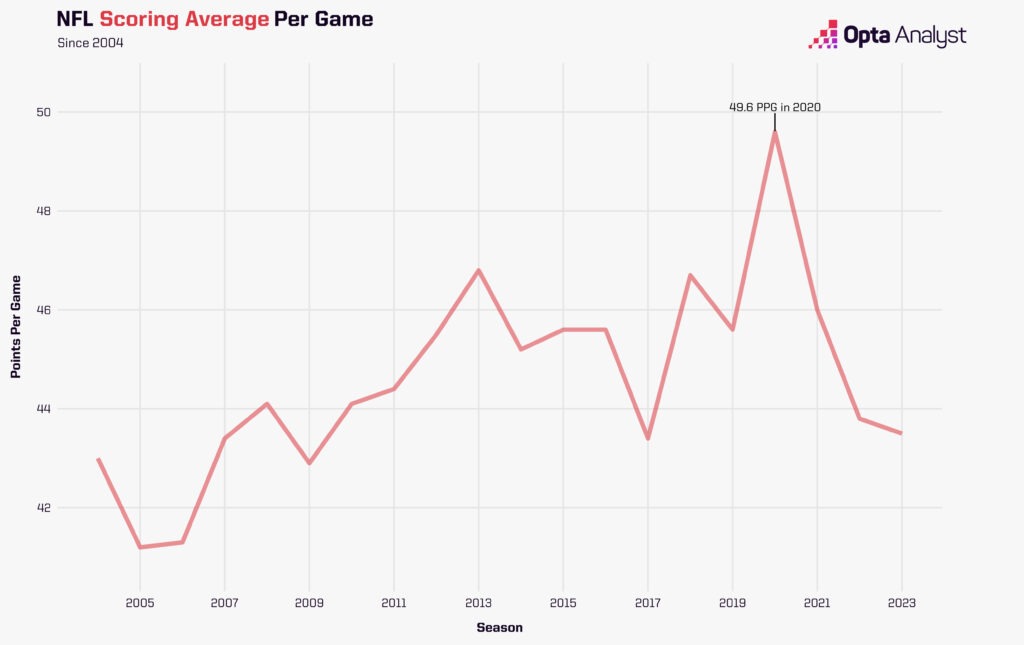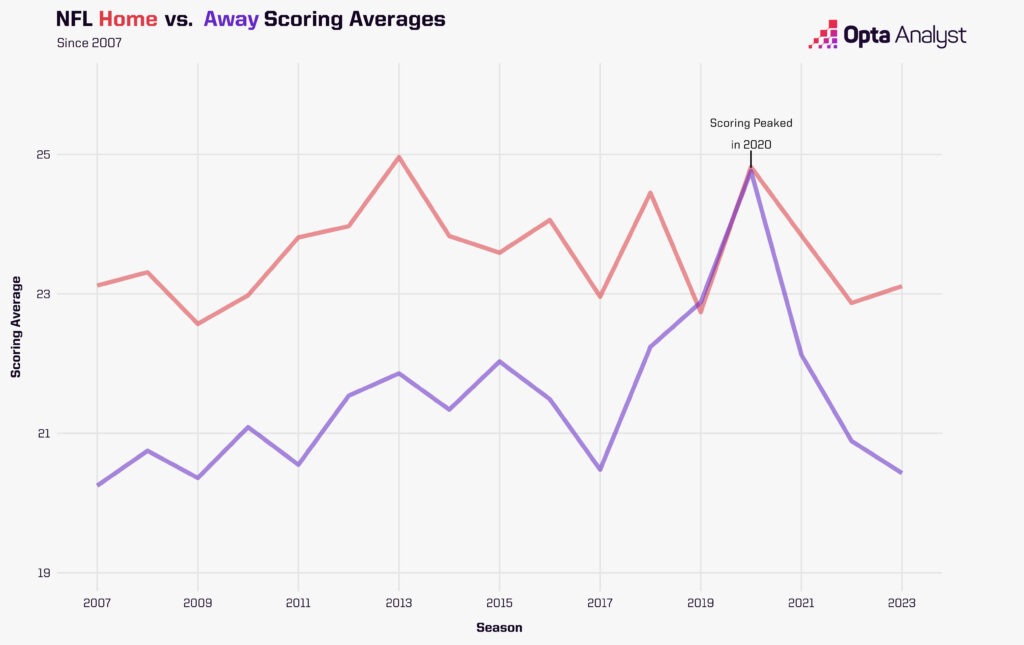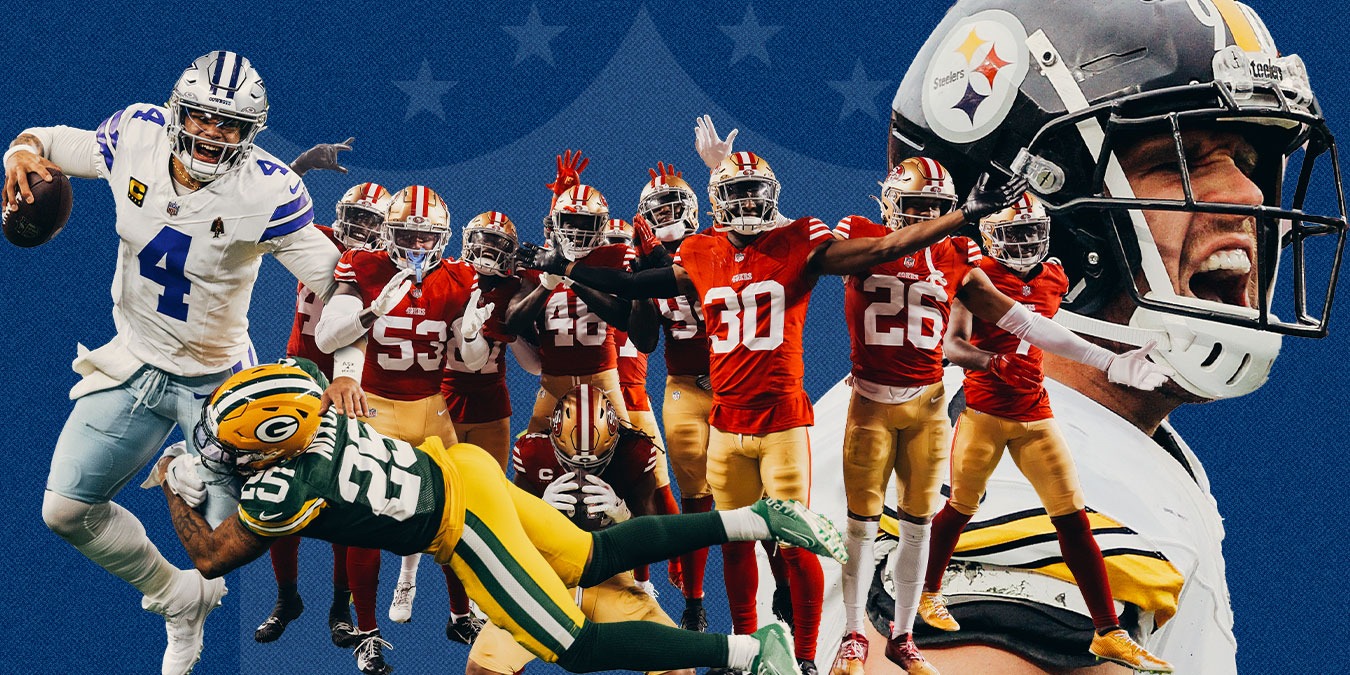NFL scoring peaked in 2020 and has fallen each year since. Drives are stalling, and it may have to do with defenses executing in the right coverages.
Caleb Williams to the Chicago Bears. Jayden Daniels to the Washington Commanders. Drake Maye to the New England Patriots. Marvin Harrison Jr. to the Arizona Cardinals.
On and on they went.
It may have appeared to be an anomaly when the 2024 NFL Draft opened with a record 14 straight offensive selections – and 23 of the 32 first-round picks, or about 72%, on that side of the ball – but teams were owning up to the desire, and perhaps downright anxiousness, to score more points.
Quite simply, it’s been a weird decade for NFL scoring.
The NFL’s history is one of offenses and defenses trading punches, with the league office sometimes putting its thumb on the scale. Scoring has ebbed and flowed in the decades since the AFL-NFL merger in 1970, and the league has tried to adjust the level of offense gradually.
It’s shifted around the hash marks to give defenses a fairer shake, only to tinker with clock rules to allow for more offensive plays and, in later decades, make a series of routine defensive plays illegal. Just this offseason, the league did it again, outlawing the so-called hip-drop tackle and making it a personal foul.
Many of those reforms have shown up unmistakably in NFL scoring totals year after year. But since the 2020 pandemic season, offenses have been in a strange place. Almost anyone would tell you the league currently enjoys a boom of quarterback and receiver talent, with some of the best offensive players ever dropping jaws in NFL stadiums – particularly in the AFC.
With three-time Super Bowl champion Patrick Mahomes, Josh Allen and Joe Burrow under center, the versatile Christian McCaffrey scoring touchdowns like a video game running back on easy mode, and Tyreek Hill chasing the single-season receiving yards record, the names and headlines are there. It’s just that the high-level scoring numbers aren’t.
In 2020, there was an average of 49.6 points per NFL game, a fantasy football dream as the highest in league history. But NFL scoring has waned in the three years since then, dropping to an even 46 points per game in 2021, then dipping even lower at 43.8 and 43.5 the past two seasons:

The one-year drop of 3.6 points on average from the 2020 to ’21 seasons was the second-largest in NFL history – the average fell from 38.3 in 1976 to 34.4 in ’77 – and the 6.1-point drop from 2020 to last season marked the largest decrease over a four-season span.
Perhaps not surprisingly, there also have been per-game drops in each season from 2020 to ’23 with scrimmage touchdowns (5.48 to 4.50), overall touchdowns (5.75 to 4.79), scrimmage yards (747.5 to 698.0), scrimmage yards per touch (7.5 to 7.2) and third-down conversion percentage (41.6 to 38.8). It’s the same in passer rating (a single-season record 93.6 to 89.0), while the single-season record 871 passing touchdowns in the 16-game regular-season schedule of 2020 fell to 750 last year, despite the last three seasons having 17-game schedules.
We won’t know for many years whether the recent decline in scoring was part of an extensive trend or just a multiyear blip. But for the moment, it’s a riddle worth investigating. Why has scoring dropped by 12.3% over the past three seasons, at a time of such striking offensive talent?
We dug into a handful of shifts that might partially explain the drop. None is a smoking gun, but together, they offer useful clues into why teams are scoring fewer points.
Third-and-a Longer Shot Than It Used to Be
NFL points come in various shapes and sizes, but the most common come from offensive drives. Put a stopper in the drive, put your opponent in a tricky spot to put up points.
The NFL-wide third-down conversion rate, dating to 1991, peaked in 2020 at 41.6%. It has fallen each season since to 38.8% in 2023. It was also 38.8% in 1993 when NFL scoring was at 37.4 points per game – the lowest PPG mark since the late 1970s. The fourth-down conversion rate has dropped in the same period. It’s becoming harder to keep a drive going to ultimately put points on the board. But where has that conversion-rate decrease come from?
Both running and throwing conversions are down. Third-down conversation rates on rushing attempts dropped from 54.2% in 2020 to 49.9 in 2023. On pass plays, it dropped from 41.2% to 39.3. The larger percentage gap in run plays may lead us to initially point fingers at the ground game, but there were 4,874 passing attempts on third down in 2023 compared to 1,749 rushing attempts – or about three times as many. About half of those rushing attempts came on third-and-2 or shorter, which leaves a lot of passing attempts to analyze as we go up in distance. From 3 to 7 yards, third-down passing conversion is negligibly up (48.3% from 48.1% in 2020), so that leaves us with longer-yardage passing situations to account for plenty of the overall decrease.
Yards per attempt on third-and-8-10 yards is down while the number of such throwing situations per game is up. The first-down rate on such plays is down from 35.0% in 2020 to 32.8% in 2023. Likewise, yards per attempt on third-and-11+ is down and the frequency of such situations per game is up. The first-down rate in such situations is down from 19.2% to 16.8%:

With those conversion rates down, it follows that punts are up. There were 8.32 punts per game in 2023, which is an increase from 7.43 in 2020. The percentage of drives ending in a punt was 37.6 in 2023, up each year since 2020 when it was 34.1. Two takeaways from that, one obvious and the other not: More drives are ending without the score increasing, and you likely owe the Chicago Bears an apology for your reaction to them drafting Iowa punter Tory Taylor in the fourth round of this year’s draft.
But it’s worth noting 2023 punt rates are merely back to 2019 levels (37.7%) and still remain down from the past two decades while scoring in 2019 was still a few points higher than it is now. Going a layer deeper, the net average on punts is at an all-time high (41.6 yards), which is a 1.3-yard increase from 2020.
So is field position also a consideration? Perhaps. More drives per game started between the goal line and 25-yard line in 2023 (14.56) than the previous three seasons (14.08 in 2020). And while over a quarter of all drives ended in a TD in 2020 (25.2%), that number has dipped each season since to 20.3%. The percentages of drives resulting in field goal attempts and makes have remained much more constant.
There’s a lot going on here, and while none of it on its own is the ah-ha stat, none of it appears to be positive for scoring points.
Let’s for a moment go back to those longer-yardage passing scenarios that are killing drives. Those less successful third-down attempts are happening while completion percentage of them is actually on the rise. At third-and-8+ yards, completion percentage has gone up about a percent and a half from 2020 to 2023. Is that enough to say defenses seem to be learning effective ways to accept a completion while not allowing a first down or a big play?
If so, what’s going on with coverages?
Safety First
Explosive plays drive high-scoring totals. Get the ball down the field fast, and whether a drive stalls or ends in a touchdown, there’s more time on the clock for the opponent to score or for that original offense to get the ball back and score again. At the same time, moving the ball quickly reduces the number of chances to turn it over. A quarterback is less likely to make a crippling mistake on a six-play drive than a plodding 14-play march.
Unfortunately for offenses, NFL defensive coordinators have reached this same conclusion. And in recent seasons, they’ve deployed tactics designed to make offenses bleed for every yard they get.
We define an explosive play as 20+ yards per pass or 10+ yards per run on a play run from between the two teams’ 20-yard lines. The league-wide explosive-play rate (EPR) hasn’t fluctuated much since 2017, but, not surprisingly, it’s been highest when defenses have not lined up with a high safety to take away long passes. The EPR against Cover-0 (no high safety) is 12.7%. Against Cover-2 (two high safeties) and Cover-4 (four high defenders, often including cornerbacks), the EPR is just over 9%.
Which coverages have defenses gravitated toward of late? You can probably guess.
Middle of the field closed (MOFC) defenses involve a single high safety patrolling the middle of the field. They include Cover-1 and Cover-3 alignments. Middle of the field open (MOFO) defenses have several safeties (Cover-2, Cover-4, Cover-6) back deep in an effort to limit downfield passes.
The more conservative MOFO alignments have become more popular each year since 2017. In 2020, defenses played middle of the field open on 40.9% of their snaps in this 60-yard area of the field. The share has gone up every year since then and reached 43.9% last season. Another way of putting it: Every year, NFL offenses have to contend with more deep defenders who are there to stop the deep ball.
Those extra deep defenders have had their intended effect. It’s not easy to land explosive plays against defenses that are geared specifically to stop them. And typically, offenses have not:
In the Zone
It’s not just a matter of safety alignment. Zone coverage consistently does a better job limiting explosive plays than man coverage. Since 2017, zone coverage has allowed slightly more yards per play (7.2, when including sacks and scramble attempts) than man coverage (6.9) but yielded a much smaller EPR (12.3% to 9.6%).
Coordinators have been happy to make that trade. Zone coverage climbed from 61.7% of plays between the 20s in 2017 to 71.9% last season. Explosive play rates, as well as the quick score, have suffered as a result:
Pandemic Season Outlier With NFL Scoring?
The changes in defensive strategy have played a clear role in making it harder for offenses to score quickly. And they have gotten more severe each year, making quick points much harder to come by in the mid-2020s than they were in the 2020 pandemic season. But these shifts were underway during the late 2010s, and they didn’t prevent the boom to nearly 50 points per game in the 2020 season.
So, what happened that year?
It wasn’t a boom in the rushing game. The average carry went for 4.4 yards – one of the bigger numbers in league history, but smaller than the 2022 season’s 4.5 average and basically even with 2018’s 4.4 average.
It also wasn’t a matter of teams drastically changing their run-to-pass splits and airing the ball out. The league had a 54.7% pass rate in 2020 – a shade higher than the past few seasons, but lower than several lower-scoring seasons during the 2010s.
One thing was different, though: NFL quarterbacks had one of their more-efficient passing seasons ever. Included was a combined 3.4 touchdown passes per game – the league’s all-time high.
Why would passing games thrive so much in 2020, given the long-term shifts to NFL defenses that have successfully reined in passing attacks around the league?
The year’s general randomness might have had a lot to do with it. NFL rosters were in flux every week as players tested positive for COVID-19 or needed to quarantine. Some weeks, teams were woefully shorthanded on offense, and other weeks, they were shorthanded on defense. There were a lot of opportunities for things to get weird.
Games also were played in partially or wholly empty stadiums that season. The NFL piped in standardized crowd noise across the league, but stadiums were mausoleum-like. The relative quiet could have allowed for better pre-snap communication, and that could have benefited offenses more than defenses.
Did it? The data supports the idea. In 2020, the difference in NFL scoring between road teams and home teams was smaller than in any other season in recent history:

The 2020 season included roster chaos all over the league, and it nearly eliminated (or at least standardized) the crowd noise working against the visiting offenses. The result was an offensive explosion.
What’s Next With NFL Scoring?
Offense against defense is an NFL-wide chess match.
Offenses gained the upper hand during the 2010s and hit a crescendo in 2020, all the while front offices gradually became obsessed with hiring head coaches from offensive backgrounds.
One of the lessons of the past three NFL seasons is defensive coordinators also have a few tricks up their sleeves, even if they’re playing the roles of the silent (drive) killers. We may remember the 2023 regular season in part for the emergence of Mike McDaniel’s Miami Dolphins offense and their 70-20 Week 3 win over the Denver Broncos. Headline-grabbing moments such as that made it at times feel as though offense had taken a step forward in 2023.
But points are actually at a premium, and it was the Kansas City Chiefs who won the Super Bowl – after finishing 15th in scoring with the same number of offensive touchdowns as the Washington Commanders.
It’s now on the offensive whiz kids to figure out something new to raise NFL scoring again. That is (hopefully) a better plan than waiting for another world-altering event to shake things up.
Yes, welcome Caleb Williams, Jayden Daniels and Co. Fans of higher point totals are awaiting your move.
Check out our MLB, NBA and NFL coverage. Follow us on X and Instagram for more.
